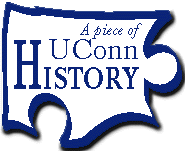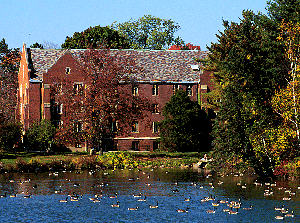This is an archived article. For the latest news, go to the Advance Homepage. For more archives, go to the Advance Archive/Search Page  | |||
|
Reflections on Mirror Lake
October marks 75th anniversary September 29, 1997 Next month will be the anniversary of a campus landmark: Mirror Lake will be 75 years old.
Once a marshy meadow, fed by a small brook, in summer it became a breeding ground for swarms of mosquitoes that fed on faculty families living in nearby houses. The now picturesque island with its lofty evergreens was a clump of weeds and rushes in 1918 when Connecticut Agricultural College acquired the land from the Whitney family. A small wooden dam was located at the northeast corner, forming what was barely a pond and more like a swamp.
From 1908, the freshman and sophomore classes had held an annual rope pull across Swan Lake. (In most other locations both of these bodies of water would be categorized as ponds - here they are lakes - as majestic in name as Superior or Tahoe.) The lake also had been used for ice skating and for many years in the pre-refrigerator era, students harvested blocks of ice to service the ice chests of the campus creamery, dining halls, and faculty homes. Then, in 1922, the wooden dam was replaced with a 250-foot soil dam. (The dam was reinforced in 1935 after heavy spring rains caused a leak. The wooden dam gate was replaced with a concrete gate.) Weeds were cleared; earth was moved to build up a mound, forming the island; and pine seedlings were planted. When the work began in May, there was already talk of moving the annual rope pull from Swan Lake. In the fall, when students returned, The Connecticut Campus held a contest to name the lake. In October, it became Mirror Lake and the rope pull, which would last into the 1950s, was moved to its shores. Late in the 1930s the pines were replaced with spruces planted by Professor Albert E. Moss of the College of Agriculture. Some of the pines had fallen, and others were damaged by muskrats that lived on the lake - the critters were trapped and removed. There have been other critter problems since then, too: in the 1970s and 1980s the lake suffered from an overpopulation of ducks and Canada geese. Concerned about how these wild animals would fare during the winter, some local residents began feeding the birds daily. With meals readily available, the birds stopped migrating to warmer regions. And seagulls started to congregate as well. Soon the lake was dying from an overabundance of excrement. Feeding the birds was banned by state statute in the 1980s and game wardens moved the waterfowl to other locales. The bird population now under control, it's not unusual to see occasional heron perched on a rock near the island. That there are fish living in this small body of water can be a surprise to a first-time observer. That they are orange or combinations of orange, yellow, black and white is even more surprising. These multi-colored fish are descendants of abandoned pet goldfish. For a time after the mid-1960s there were also white ducks paddling through the water - more abandoned pets, gifts between students at Easter that could no longer be hidden in dorm rooms. Although students used to use the lake for boating, sailing, and ice skating, the opening of the Ice Rink in 1965 brought an end to its use for skating, and human activity in or on the water is no longer allowed. Mark J. Roy
Sources: Connecticut Daily Campus, May 10, 1967, "Paradise
for Ducks, Turtles, Lovers", Cornelia Anderson; unpublished manuscript,
Evan Hill, 1980.
|


